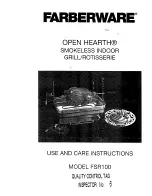
Check expansion tank
1. Expansion tanks provide space for water to move in
and out as the heating system water expands due to
temperature increase or contracts as the water cools.
Tanks may be open, closed or diaphragm or bladder
type. See Section 6 - Hydronic Piping for suggested best
location of expansion tanks and air eliminators.
Check boiler relief valve
1. Inspect the relief valve and lift the lever to verify flow.
Before operating any relief valve, ensure that it is piped
with its discharge in a safe area to avoid severe scald
potential. Read Section 6 - Hydronic Piping before
proceeding further.
Safety relief valves should be re-inspected
AT LEAST ONCE EVERY THREE
YEARS, by a licensed plumbing contractor
or authorized inspection agency, to ensure
that the product has not been affected
by corrosive water conditions and to
ensure that the valve and discharge line
have not been altered or tampered with
illegally. Certain naturally occurring
conditions may corrode the valve or its
components over time, rendering the
valve inoperative. Such conditions are
not detectable unless the valve and its
components are physically removed and
inspected. This inspection must only
be conducted by a plumbing contractor
or authorized inspection agency – not
by the owner. Failure to re-inspect the
boiler relief valve as directed could result
in unsafe pressure buildup, which can
result in severe personal injury, death, or
substantial property damage.
Following installation, the valve lever
must be operated AT LEAST ONCE
A YEAR to ensure that waterways
are clear. Certain naturally occurring
mineral deposits may adhere to the valve,
rendering it inoperative. When manually
operating the lever, water will discharge
and precautions must be taken to avoid
contact with hot water and to avoid water
damage. Before operating lever, check
to see that a discharge line is connected
to this valve directing the flow of hot
water from the valve to a proper place
of disposal. Otherwise severe personal
injury may result. If no water flows, valve
is inoperative. Shut down the boiler until
a new relief valve has been installed.
2. After following the warning directions in this manual, if
the relief valve weeps or will not seat properly, replace the
relief valve. Ensure that the reason for relief valve weeping
is the valve and not over-pressurization of the system due
to expansion tank waterlogging or undersizing.
WARNING
WARNING
12
Maintenance
(continued)
Inspect ignition / flame sense
electrodes
1. Remove the ignition / flame sense electrode from the boiler
heat exchanger access cover.
2. Remove any deposits accumulated on the ignition/flame
sense electrode using sandpaper. If the electrode cannot
be cleaned satisfactorily, replace the ignition/flame sense
electrode with a new one.
3. Replace ignition/flame sense electrode, making sure gasket
is in good condition and correctly positioned.
Check ignition ground wiring
1. Inspect boiler ground wire from the heat exchanger access
cover to ground terminal strip.
2. Verify all wiring is in good condition and securely attached.
3. Check ground continuity of wiring using continuity meter.
4. Replace ground wires if ground continuity is not satisfactory.
Check all boiler wiring
1. Inspect all boiler wiring, making sure wires are in good
condition and securely attached.
Check control settings
1. Set the boiler control module display to Parameter Mode and
check all settings. Adjust settings if necessary. See Section
11 - Operating Information for adjustment procedures.
2. Check settings of external limit controls (if any) and adjust
if necessary.
Perform start-up and checks
1. Start boiler and perform checks and tests specified in
Section 10 - Start-up.
2. Verify cold fill pressure is correct and that operating
pressure does not go too high.
Check burner flame
1. Inspect flame through observation window.
2. If the flame is unsatisfactory at either high fire or low fire,
turn off boiler and allow boiler to cool down. Remove the
burner and clean it thoroughly using a vacuum cleaner or
compressed air. Do not use compressed air to clean burner
if performed inside a building.
3. Remove the burner, reference FIG. 12-2 (page 72).
4. When replacing the burner, ensure gasket is in good
condition and positioned correctly (FIG. 12-2).
71
Installation & Service Manual
F I R E T U B E C O M B I
™
















































